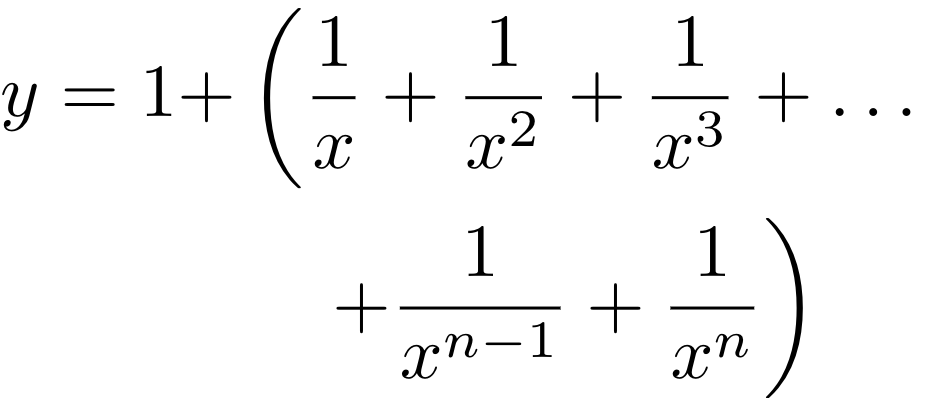Brackets and Parentheses
Introduction
Parentheses and brackets are very common in mathematical formulas. You can easily control the size and style of brackets in LaTeX; this article explains how.
Here's an table of listing some common math braces and parentheses used in LaTeX:
| Type | LaTeX markup | Renders as |
|---|---|---|
| Parentheses; round brackets | (x+y)
|
\((x+y)\) |
| Brackets; square brackets | [x+y]
|
\([x+y]\) |
| Braces; curly brackets | \{ x+y \}
|
\(\{ x+y \}\) |
| Angle brackets | \langle x+y \rangle
|
\(\langle x+y\rangle\) |
| Pipes; vertical bars | |x+y|
|
\(\displaystyle| x+y |\) |
| Double pipes | \|x+y\|
|
\(\| x+y \|\) |
Some examples
The size of brackets and parentheses can be manually set, or they can be resized dynamically in your document, as shown in the next example:
\[
F = G \left( \frac{m_1 m_2}{r^2} \right)
\]
Open this LaTeX fragment in Overleaf
The above example produces the following output:
\[
F = G \left( \frac{m_1 m_2}{r^2} \right)
\]
Notice that to insert the parentheses or brackets, the \left and \right commands are used. Even if you are using only one bracket, both commands are mandatory. \left and \right can dynamically adjust the size, as shown by the next example:
\[
\left[ \frac{ N } { \left( \frac{L}{p} \right) - (m+n) } \right]
\]
Open this LaTeX fragment in Overleaf
The above example produces the following output:
\[\left[ \frac{ N } { \left( \frac{L}{p} \right) - (m+n) } \right]\]
When writing multi-line equations with the align, align* or aligned environments, the \left and \right commands must be balanced on each line and on the same side of &. Therefore the following code snippet will fail with errors:
\begin{align*}
y = 1 + & \left( \frac{1}{x} + \frac{1}{x^2} + \frac{1}{x^3} + \ldots \\
& \quad + \frac{1}{x^{n-1}} + \frac{1}{x^n} \right)
\end{align*}
Open this LaTeX fragment in Overleaf (with errors)
The solution is to use "invisible" brackets to balance things out, i.e. adding a \right. at the end of the first line, and a \left. at the start of the second line after &:
\begin{align*}
y = 1 + & \left( \frac{1}{x} + \frac{1}{x^2} + \frac{1}{x^3} + \ldots \right. \\
&\left. \quad + \frac{1}{x^{n-1}} + \frac{1}{x^n} \right)
\end{align*}
Open this LaTeX fragment in Overleaf
The above example produces the following output:

Controlling types and sizes
The size of the brackets can be controlled explicitly, as shown in this LaTeX code fragment:
\[
\Biggl \langle 3x+7 \biggr \rangle
\]
Open this LaTeX fragment in Overleaf
The above example produces the following output:
\[\Biggl \langle 3x+7 \biggr \rangle\]
The commands \Biggl and \biggr establish the size of the delimiters < and > respectively, with the l or r indicating whether it's the left or the right parenthesis. For a complete list of parentheses and sizes see the reference guide.
Reference guide
| LaTeX markup | Renders as |
|---|---|
\bigl( \Bigl( \biggl( \Biggl(
|
|
\bigr] \Bigr] \biggr] \Biggr]
|
|
\bigl\{ \Bigl\{ \biggl\{ \Biggl\{
|
|
\bigl \langle \Bigl \langle \biggl \langle \Biggl \langle
|
|
\bigr \rangle \Bigr \rangle \biggr \rangle \Biggr \rangle
|
|
\big| \Big| \bigg| \Bigg|
|
\(\displaystyle\big| \; \Big| \; \bigg| \; \Bigg|\) |
\big\| \Big\| \bigg\| \Bigg\|
|
\(\displaystyle\big\| \; \Big\| \; \bigg\| \; \Bigg\|\) |
\bigl \lceil \Bigl \lceil \biggl \lceil \Biggl \lceil
|
\(\displaystyle\big \lceil \Big \lceil \bigg \lceil \Bigg \lceil\) |
\bigr \rceil \Bigr \rceil \biggr \rceil \Biggr \rceil
|
\(\displaystyle\big \rceil \Big \rceil \bigg \rceil \Bigg \rceil\) |
\bigl \lfloor \Bigl \lfloor \biggl \lfloor \Biggl \lfloor
|
\(\displaystyle\big \lfloor \Big \lfloor \bigg \lfloor \Bigg \lfloor\) |
\bigr \rfloor \Bigr \rfloor \biggr \rfloor \Biggr \rfloor
|
\(\displaystyle\big \rfloor \Big \rfloor \bigg \rfloor \Bigg \rfloor\) |

![{\displaystyle {\big ]}{\Big ]}{\bigg ]}{\Bigg ]}}](https://wikimedia.org/api/rest_v1/media/math/render/svg/7aec0f2dd592401b2f08fe01f8908e45955784aa)


